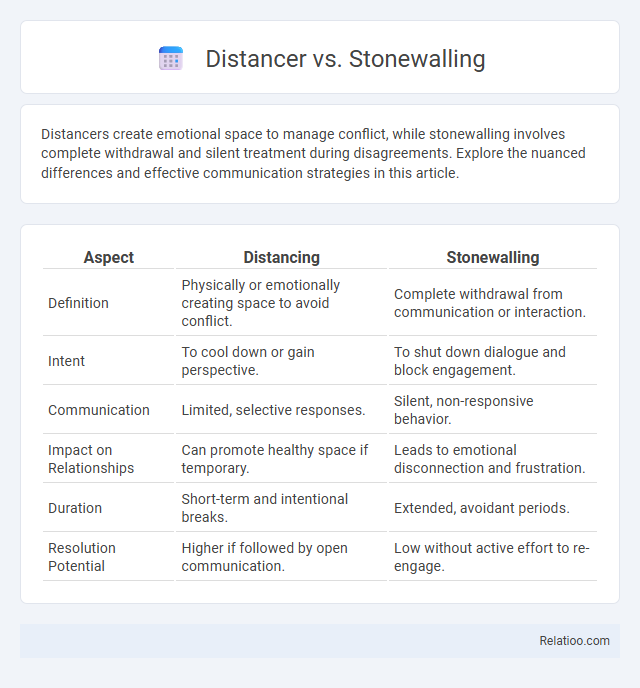Distancers create emotional space to manage conflict, while stonewalling involves complete withdrawal and silent treatment during disagreements. Explore the nuanced differences and effective communication strategies in this article.
Table of Comparison
| Aspect | Distancing | Stonewalling |
|---|---|---|
| Definition | Physically or emotionally creating space to avoid conflict. | Complete withdrawal from communication or interaction. |
| Intent | To cool down or gain perspective. | To shut down dialogue and block engagement. |
| Communication | Limited, selective responses. | Silent, non-responsive behavior. |
| Impact on Relationships | Can promote healthy space if temporary. | Leads to emotional disconnection and frustration. |
| Duration | Short-term and intentional breaks. | Extended, avoidant periods. |
| Resolution Potential | Higher if followed by open communication. | Low without active effort to re-engage. |
Understanding the Concept: Distancer vs Stonewalling
Understanding the concept of Distancer vs Stonewalling reveals key differences in communication styles that impact relationship dynamics. Distancers often create space to process emotions and regain control, while stonewallers typically shut down and refuse to engage, causing emotional withdrawal. Recognizing these behaviors can help you address conflicts more effectively and improve your emotional connection.
Key Psychological Traits of Distancers
Distancers exhibit key psychological traits such as emotional withdrawal, a strong need for independence, and discomfort with vulnerability, often avoiding intimate conversations to maintain personal space. Unlike stonewallers, who shut down communication defensively and resist engagement, distancers actively seek distance to regulate their emotional environment. Their behavior reflects an internal struggle with trust and intimacy, leading to patterns of avoidance that can challenge relationship dynamics.
Stonewalling: Definition and Core Characteristics
Stonewalling is a communication barrier characterized by emotional withdrawal and refusal to engage in conversation, often manifesting as silence, avoiding eye contact, or physically leaving the situation. It differs from distancer behavior, which involves creating space to process emotions, and from pursuer tactics that seek closeness or resolution. Core characteristics of stonewalling include shutdowns during conflicts, emotional detachment, and a defensive stance that prevents effective dialogue and resolution.
Common Triggers for Distancing and Stonewalling
Common triggers for distancing include feeling overwhelmed, fearing conflict, or needing space to process emotions, often leading to withdrawal or avoidance. Stonewalling is frequently triggered by emotional flooding, frustration, or perceiving a partner's criticism as a personal attack, resulting in a shutdown or refusal to engage. Both distancing and stonewalling serve as protective mechanisms against emotional vulnerability but differ in expression: distancing pulls away physically or emotionally, while stonewalling blocks communication entirely.
Emotional Impact on Relationships
Stonewalling generates profound emotional distance by shutting down communication, resulting in feelings of isolation and frustration within relationships. Distancers create emotional withdrawal that can lead to partners feeling neglected and undervalued, amplifying insecurity and emotional pain. Understanding the emotional impact of stonewalling and distancing behaviors is essential for addressing communication barriers and fostering healthier relationship dynamics.
Communication Patterns in Distancer and Stonewalling Dynamics
Distancer communication patterns involve emotional withdrawal and avoidance, creating space to manage stress, while stonewalling is characterized by complete shutdown and refusal to engage, often exacerbating conflict escalation. Distancers typically use subtle cues and indirect communication to signal discomfort, whereas stonewallers employ silence and non-responsiveness as defensive mechanisms. Understanding these dynamics is crucial for addressing communication barriers and fostering healthier interaction in relationships marked by these behaviors.
Signs You Might Be a Distancer or Stonewaller
Signs you might be a Distancer include consistently avoiding emotional conversations, needing excessive personal space, and withdrawing physically or emotionally during conflicts. Stonewalling is characterized by shutting down communication, giving silent treatment, and showing resistance to engaging in problem-solving discussions. Recognizing these behaviors early can help address relationship issues by promoting healthier communication patterns.
Root Causes: Why People Distance or Stonewall
Distancing and stonewalling both stem from emotional self-protection but differ in expression and intent, with distancers seeking space to process feelings calmly while stonewallers shut down communication to avoid conflict or overwhelm. Root causes often include fear of vulnerability, unresolved past traumas, and low emotional regulation skills, which hinder open dialogue and connection. Understanding your partner's underlying fears and triggers can help address these patterns and foster healthier interaction.
Breaking the Cycle: Strategies for Change
Breaking the cycle of Distancer and Stonewalling requires understanding the underlying fears driving these behaviors and fostering open communication. You can implement strategies such as establishing safe emotional spaces, practicing active listening, and setting clear boundaries to create trust and reduce avoidance. Consistent effort in recognizing and addressing these patterns promotes healthier connection and conflict resolution.
Seeking Help: When and How to Get Support
Distancer, Stonewalling, and Distancer behaviors each impact the ability to seek help in relationships, with Distancers often avoiding emotional expression and Stonewalling involving emotional shutdown. Recognizing when emotional withdrawal or silence hinders communication is critical for timely support. Seeking professional therapy or couples counseling can provide structured guidance to overcome these patterns and foster healthier emotional engagement.

Infographic: Distancer vs Stonewalling
 relatioo.com
relatioo.com